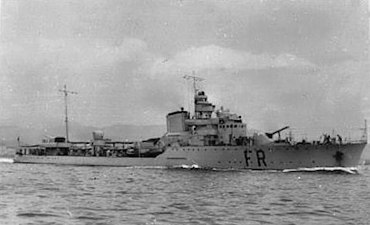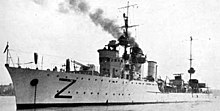Dardo class
|
Dardo class |
|
|---|---|
 The destroyer Freccia The destroyer Freccia
|
|
| overview | |
| Ship type : | destroyer |
| Units: | 4 built on 2 shipyards: Odero, Sestri Ponente Cantiere Tirenno, Riva Trigoso |
| Keel laying : | January to May 1929 |
| 1. Launch : | August 3, 1930 Freccia |
| 1. Commissioning: | October 15, 1931 Freccia |
| Use until: | 1943; Dardo as TA 31 briefly in 1944 |
| Technical specifications | |
| Displacement : | 1,400 ts standard 2,116 ts maximum |
| Length: | 96.2 m above sea level, 92.2 m pp. FF, SA 94.1 m above sea level, 92.2 m pp. DR, ST |
| Width: | 9.75 m |
| Draft : | 3.15 m |
| Drive : | 3 Thornycroft - boilers 2 Parsons turbines with single transmission 44,000 hp (32,800 kW ) |
| Fuel supply: | 630 tons of oil |
| Speed : | 38 kn (70 km / h ) |
| Range : | 3,600 nm at 12 kn |
| Crew : | 156-183 |
| Armament: | 4 × 120/50 mm guns (2 × 2) 2 × 40/39 mm pom pom 4 × 13.2 mm Breda - Fla - MG (2 × 2) 6 × 533 mm Torpedo tube (2 × 3) 2 depth charges 54 sea mines 1939–41: "pompom" and Fla-MG replaced |
The Dardo-class was a destroyer- class of the Italian Navy that consisted of four destroyers that entered service between October 1931 and June 1932. They were built at the Cantieri del Tirreno shipyards in Riva Trigoso and Cantieri Navali Odero in Sestri Ponente , which had already received orders from the Navy for destroyers of the previous classes. Of the four destroyers, three resumed names of the Lampo class ( Freccia , Dardo , Strale ) that had been delivered to the Italian Navy by the German Schichau shipyard in Elbing at the beginning of the century. The name of the predecessor Saetta however, was a built in Italy Torpedo Aviso , who was from 1887 to 1908 in the service of the Regia Marina.
Some sources also refer to the four destroyers as the Freccia class , as the Freccia , built in Riva Trigoso, was the first of the four destroyers to be launched on August 3, 1930 and entered service on October 15, 1931.
History of the class
The destroyers ordered in 1928 were to be used together with the heavy cruisers of the Zara class . Therefore, it seemed necessary to improve performance in the areas of speed and range. The improved type was developed from the turbine class . It received a higher propulsion power, improved 120 mm guns with the same basic layout and distribution of the armament and a higher fuel supply through side tanks. These measures led to larger ships with more hull width. In the case of the Dardo and Strale built in Sestri Ponente , the almost vertical bow of the previous series was retained, while the two newbuildings from Riva Trigoso received an unusual, yacht-like foredeck, which proved to be advantageous in use. Originally the destroyers of the Dardo / Freccia class were supposed to have two funnels like their predecessors. In order to improve the fire areas of the anti-aircraft weapons, the exhaust pipes of the three boilers were merged into a large chimney, which became a hallmark of all Italian destroyers and torpedo boats built up until the Second World War.
One shortcoming of the destroyers was their poor stability in bad weather due to the installation of side tanks and heavier weapons and fire control systems. This was particularly evident when the fuel was largely consumed, so that as much as possible should remain on board, which reduced the range of the destroyers. Attempts to fill empty tanks with water ballast reduced the quality of the fuel supply in the long run. The ships were therefore provided with fixed ballast and side keels. These measures made the ships heavier and increased the overloading of the hulls. Instead of the planned standard displacement of 1205 ts, this increased to 1400 ts and reduced the possible maximum speed of the units. Under normal conditions of use, the destroyers could rarely reach more than 30 knots.
The four destroyers of the following, almost simultaneously emerging Folgore class , which were built between 1929 and 1932 at the Cantieri del Quarnaro shipyards in Fiume and Officine & Cantieri Partenopei in Naples , were initially referred to as the 2nd group of the Dardo class.
Assignments at the Regia Marina
During the Spanish Civil War , the destroyers were used to monitor shipping traffic to Spain. In August 1937, undetected, the destroyers attacked two tankers carrying oil for the Spanish Republicans near the Tunisian coast and sank the Compeador tanker .
When Italy entered the Second World War on the side of Germany in June 1940, the four destroyers in Taranto formed the " VII Squadriglia Cacciatorpediniere (7th destroyer squadron) ", which was to be used with the heavy units of the fleet.
On June 13, 1940, the Strale succeeded in sinking the British submarine Odin off Taranto.
From July 7, 1941, Freccia , Saetta , Dardo and Strale were at sea to secure the 5th Division, consisting of the battleships Giulio Cesare and Conte di Cavour , to set up a convoy with the passenger ships Esperia (11,398 GRT), Calitea (4013 BRT), Marco Foscarini (6342 BRT), Vettor Pisani (6339 BRT) and the freighter Francesco Barbero (6343 BRT). On board the ships were 2,200 soldiers, 300 armored vehicles and trucks as well as 16,000 tons of material. The Italian fleet was at sea with the majority of its units to bring the convoy safely to Tripoli , which arrived there on July 8th without losses. An advance by the Italian fleet against the British Mediterranean fleet led to the naval battle at Punta Stilo on the 9th , which was broken off by the Italians after a heavy hit on the Giulio Cesare by the Warspite .
Units of the Marina Regia
| Surname | Shipyard | Keel laying | Launch | in service | Whereabouts |
|---|---|---|---|---|---|
| Freccia FF | Riva Trigoso | 02/20/1929 | August 3, 1930 | 10/21/1931 | sunk in Genoa by British bombers on August 8, 1943 |
| Dardo | Sestri Ponente | 01/23/1929 | September 6, 1930 | 01/25/1932 | Confiscated by the Navy in Genoa on September 9, 1943, not ready for use , briefly on duty as TA 31 , blown up on April 25, 1945 during the German retreat in Genoa |
| Strale | Sestri Ponente | 02/20/1929 | 03/26/1931 | February 6, 1932 | accrued on June 21, 1942, the Tunisian coast, on August 6, 1942, the British submarine Turbulent destroyed |
| Saetta | Riva Trigoso | May 27, 1929 | January 17, 1932 | 05/10/1932 | Sank on February 3, 1943 off Tunisia after being hit by a mine |
Export buildings
The four Kountouriotis class destroyers built in Italy for Greece are mostly assigned to the Dardo class. They were built at Odero in Sestri Ponente between 1930 and May 1933. At 94.3 m above sea level and 92.4 m pp, the dimensions of the hull largely corresponded to those of the Dardo and Strale of the Regia Marina, which were built at the same shipyard . The bridges were, however, lower and their main armament also consisted of four 120 mm cannons, but they were installed as individual guns on the foredeck and aft so that they could overshot each other. In tests, Spetsai is said to have reached the highest speed of a ship in this group of 41.5 knots, with the machine producing 52,000 hp at that time.
Even before the Greek order, Turkey had also ordered four destroyers in Italy, of which the first two ( Kocatepe , Adatepe ) were built between January 1930 and October 1931 at Ansaldo in Genoa. With a length of 100.2 m above sea level (98.0 m pp.) These ships were longer than the Dardo and Folgore classes. They had their main armament - like the Greek ships - set up as individual guns on top of one another and they had two funnels like the turbine class. A second pair ( Tinaztepe , Zafer ) was created in Riva Trigoso until June 1932 and was only 96.0 m above sea level. (93.6 m pp) long. These two destroyers had twin guns like the Italian half-sisters. The four Turkish ships are often assigned to the Folgore class.
literature
- MH Whitley: Destroyers of World War 2. Cassell Publishing, 1988, ISBN 1-85409-521-8 .
Web links
Individual evidence
- ↑ DARDO 1900
- ↑ SAETTA 1887
- ↑ MV Campeador (+1937)
- ^ Rohwer: Sea War. 10-25 June 1940, Mediterranean Sea, Allied submarines in action.
- ^ Rohwer: Sea War. 6-11 July 1940, Mediterranean Sea, Battle of Punta Stilo (Calabria).


